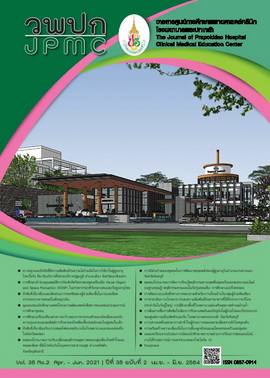Psychometric Properties of Visual Object and Space Perception (VOSP) in Healthy, Older, Thai Adults: A Pilot Study
Main Article Content
Abstract
BACKGROUND: Visual Object and Space Perception battery (VOSP) complies a series of tasks comprehensively represent object and space perception abilities. However, VOSP has not been validated in Asian population.
OBJECTIVES: This study aimed to obtain preliminary normative data relating to VOSP for older Thai adults and to identify the demographic variables influencing their scoring performance on each VOSP subtest. Furthermore, the practicality and convenience of VOSP focusing on testing time, appropriateness of image size, and clarity of images and instructions was also investigated.
METHODS: After getting written permission from Pearson Education Ltd. to translate VOSP, the Incomplete Letters subtest in Thai alphabets was created and linguistic validation of VOSP instructions was done. Forty healthy, older, Thai adults were recruited and stratified into 8 groups by age, gender, and education. Performance of the participants on each VOSP subtest scores, testing time and clarity of each VOSP subtests stimuli and instructions were demonstrated by descriptive statistics. Multiple linear regression analyses were performed to identify potential significant contributions of demographic variables to the VOSP subtest scores performances.
RESULTS: The preliminary scores for each VOSP subtest were comparable with those from other normative studies, except the Silhouettes and Object Decision subtests. Gender, intelligence quotient, and visual acuity had significant effects on certain VOSP subtest scores. Mean total testing time was 18 minutes. Most rating scores of image size and clarity of images and instructions of each VOSP subtests were indicated good to excellent quality.
CONCLUSIONS: Overall, the preliminary scores of each VOSP subtests in healthy Thai older adults were comparable with the other normative studies. The findings of this study will benefit future national normative study planning in non-native English-speaking countries.
Article Details
References
Warrington EK, James M. Visual object and space perception battery (VOSP). London: Pearson; 1991.
Videaud H, Torny F, Prado-Jean A, Couratier P. Use of the Visual object and space perception (VOSP) test battery in two cases of posterior cortical atrophy. Neurocase 2008; 15:32-6.
Quental NBM, Brucki SMD, Bueno OFA. Visuospatial function in early alzheimer's disease—the use of the visual object and space perception (VOSP) battery. PLoS One [Internet]. 2013 [cited 2020 sep 20] 16;8(7):e68398 . Avialable form: https://journals.plos.org/plosone/article?id=10.1371/journal.pone.0068398
Yamin S, Stinchcombe A, Gagnon S. Driving competence in mild dementia with lewy bodies: In search of cognitive predictors using driving simulation. Int J Alzheimers Dis 2015; 2015:806024.
Calvo L, Casals-Coll M, Sánchez-Benavides G, Quintana M, Manero RM, Rognoni T, Palomo R, ranciva F, Tamayo F, Peña-Casanova J. Spanish normative studies in young adults (NEURONORMA young adults project): norms for the visual object and space perception battery and judgment of line orientation tests. Neurologia 2013 ;28:153-9.
Peña-Casanova J, Quintana-Aparicio M, Quiñones-Ubeda S, Aguilar M, Molinuevo JL, Serradell M, et al. Spanish multicenter normative studies (NEURONORMA Project): norms for the visual object and space perception battery-abbreviated, and judgment of line orientation. Arch Clin Neuropsychol 2009;24:355-70.
Bonello PJ, Rapport LJ, Millis SR. Psychometric properties of the visual object and space perception battery in normal older adults. Clin Neuropsychol 1997;11:436-42.
Weber P, Pache M, Lütschg J, Kaiser HJ. Visual object and space perception battery: normal values for children from 8 to 12. Klin Monbl Augenheilkd 2004;221:583-7.
Kosmidis MH, Tsotsi S, Karambela O, Takou E, Vlahou CH. Cultural factors influencing performance on visuoperceptual neuropsychological tasks. Behav Neurol 2010;23:245-7.
Herrera-Guzmán I, Peña-Casanova J, Lara JP, Gudayol-Ferré E, Böhm P. Influence of age, sex, and education on the Visual Object and Space Perception Battery (VOSP) in a healthy normal elderly population. Clin Neuropsychol 2004;18:385-94.
Hertzog MA. Considerations in determining sample size for pilot studies. Res Nurs Health 2008;31:180-91.
Muangpaisan W, Assantachai P, Sitthichai K, Richardson K, Brayne C. The distribution of Thai mental state examination scores among non-demented elderly in suburban Bangkok metropolitan and associated factors. J Med Assoc Thai 2015;98:916-24.
Train the Brain Forum (Thailand) . Thai mental state examination (TMSE). Siriraj Hosp Gaz 1993;45:359-74.
Mongkol A, Visanuyothin T, Chanarong P, Pavasuthipaisit C, Panyawong W. IQ distribution of Thai students. Journal of Mental Health of Thailand 2012;20:90-102.
Hamrab P, Pavan-Langston D. Ocular examination techniques and diagnostic tests. In: Pavan-Langston D, editor. Manual of ocular diagnosis and therapy. 6th ed. Philadelphia: Lippincott Williams & Wilkins; 2008. p 5.
Aroonmanakun W, Tansiri K, Nittayanuparp P. Thai National Corpus: a progress report. In: Riza H, Sornlertlamvanich V, editor. ALR7: Proceedings of the 7th workshop on Asian language resources. Stroudsburg PA: Association for Computational Linguistics; 2009. p153-8.
Rosselli M, Ardila A. The impact of culture and education on non-verbal neuropsychological measurements: a critical review. Brain Cogn 2003;52:326-33.
Strauss E, Sherman EM, Spreen O. Tests of visual perception. a compendium of neuropsychological tests: administration, norms, and commentary. 3rd ed. New York: Oxford University Press; 2006.

